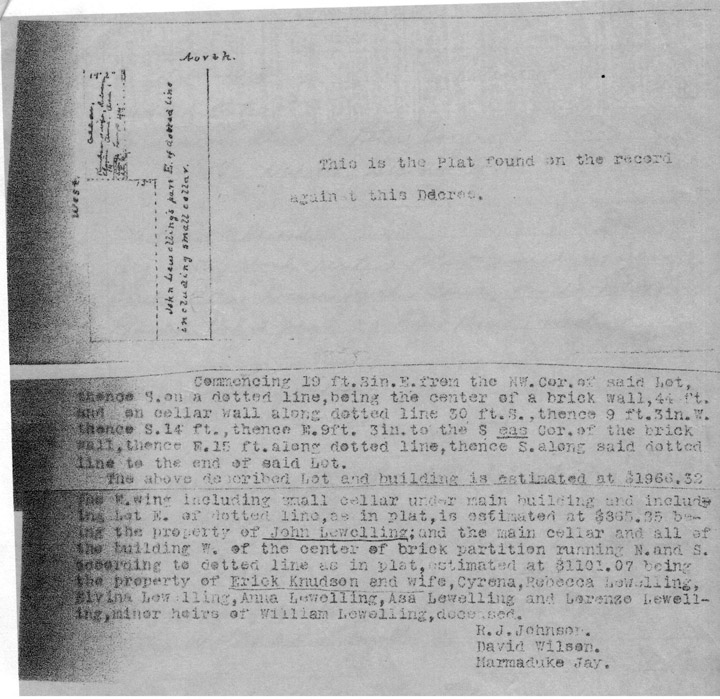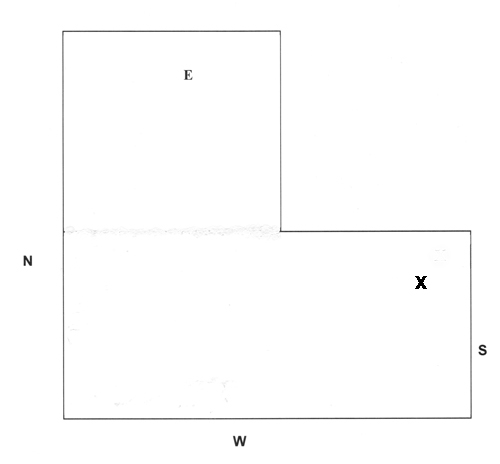Between 1841 and 1842 Henderson Lewelling was buying many lots in
Salem, Iowa. In reading land records I do not see his purchase of Lot 4
in block 19 from Street and Boyer. The abstract person could not find it
either.
Warranty Deed F-205 dated 3-10-1847 and filed on 4-6-1847, right
before Henderson and family left on the wagon train. Henderson Lewelling
and his wife Elizabeth deeded Lot 4 in Block 19 to his brother William
Lewelling. William died 10-17-1847 and this property-entered probate on
11-18-1847. William left his wife Cyrene and children Rebecca, born
1839, Elvina, born 1840, Anna, born 1842, Asa, born 1845 and Lorenzo
born 1846. In the probate there is a partition of the property. John
Lewelling ends up with part of the property and the rest is held in
trust, by the mother for the five children; they are to receive their
share when they reach adulthood.
Copy of the record I found in the abstract
of title

The property is described thus.
"Commencing 19 ft. 3 in. E from the NW corner of said Lot, thence S. on
a dotted line, being the center of a brick wall, 44 ft. and on cellar
wall along dotted line 30 ft. S., thence 9 ft 3 in. W., thence S. 14
ft., thence E, 9 ft. 3 in. to the S east cor. of the brick wall, thence
E 15 ft. along dotted line, thence S. along said dotted line to the end
of said Lot.
The above described Lot and buildings are estimated at $1,966.32. The
E. wing including small cellar under main building and including Lot E
of dotted line, as in plat, is estimated at $365.35 being the property
of John Lewelling; and the main cellar and all of the building west of
the center of brick partition running N and E according to dotted line
as in plat, estimated at $1,101.07 being the property of Erick Knudson
and wife, Cyrene, Rebecca Lewelling, Elvina Lewelling, Anna Lewelling,
Asa Lewelling and Lorenzo Lewelling, minor heirs of William Lewelling,
deceased.
Signed R. J. Johnson, David Wilson and Marmaduke Jay‚"
My drawing is below. |
Town Lots Book A page 293-294
20 October 1856 John Lewelling and his wife sell
to Vicissimus K. Phar E part of Lot 4, Block 19 for $800.00. Filed
November 14 and recorded Nov 18, 1856.
V K Phar came to Center Twp., Henry County Iowa in 1855 and is in the
census of 1856 there. He died in 1860 in Trenton Twp., Henry County
Iowa. On Ancestry.com I found he was a Presbyterian minister and was
against slavery.
Town Lots B page 525
Aug 23, 1859* Vicissimus Knox Phar and his wife Zelia Phar sell E
part of Lot 4 back to John Lewelling for $500. Phar owes back taxes for
1857, 1858 and 1859.
December 22, 1860* John Lewelling sells his E part of Lot 4 to
William C. Johnson for $200.00. In 1882 and 1884 both portions are sold
to the Conrad family.
*Both 1859 and 1860 deeds are record Feb 1, 1861. |
Let's summarize what is known
about this room and the wheel.
The big wooden wheel in the NW corner of the Lewelling house dining
room, was moved from the Beehive (One of the five known safe houses for
runaway slaves.) The wheel was in the attic and rope(s) went down
through the second floor and raised a portion of the first floor;
runaways went down steps and were hidden in a cellar 14 ft. by 9.3 ft.
Again the Quakers were ingenious. Henderson Lewelling owned the Beehive
in 1847 and sold it to his brother William in 1847, when Henderson went
to Oregon. William died in the fall of 1847 and brother John gets a 14
ft. by 9.3 ft. cellar in the Beehive. The main cellar stays with
William's widow and *family. Thus it appears all three brothers, were
involved with the Underground Railroad while living in Salem, Iowa.
From Bob Mendenhall's memories from early 1960s - summarized: The large
wooden "wheel" was located in the attic on the SW corner. A thick rope
was attached to the wheel and the rope went down to the trap door on the
first floor of the building. This room on the SW corner of the first
floor of the Beehive was where the Salem News was printed. A large iron
ring was in the center of the room that the rope would have been
attached to. The entire floor could be raised. He never saw the space
under the floor by did get to look into the attic and saw the wheel.
(Summarized from e-mail to Faye in 2007.)
Incidents involving fugitive slaves in Salem date back to 1839 when two
fugitive slaves were captures and taken back to Missouri through Salem.
The residents of Salem reportedly challenged their authority to capture
the slaves, who managed to escape with some likely assistance while they
were preparing for a hearing.

Louis Jones would write in, Quakers of Iowa,
1914, page 188-189:
"...Salem, but twenty-five miles from the Missouri line, and surrounded
by numerous wooded streams well adapted for hiding, proved for the Negro
a most advantageous place at which to stop for food. The unfailing help
which they there received soon became widely known. Could he but reach
the town where lived the people of plain grey clothes and broad brimmed
hats, the fugitive was assured of safety ...What with the heavy loads of
human freight concealed within hollow loads of hay or beneath grain
sacks filled with bran, and the strange proclivity of this Quaker folk
for midnight drive to unknown mills or markets, large numbers of
fugitive slaves were spirited away to safety by that mysterious route
which justly gained the name: "Underground Railroad". Month after month
and year after year with Quaker-like precision this work went on at
Salem--not a single slave being retaken, it is said, once he had reached
this community (Jean added: 'and hid'). The children in the homes were
trained to ask no questions, much less to answer any asked by strangers.
They were supposed to have no eyes or no ears, concerning this solemn
business. Among the adults vague but well understood terms were used in
conversing on this subject; and while it is certain that this grave
concern was frequently the subject of guarded discussion in the two
Monthly Meetings, still on the records no written reference to the
subject is to be found."
It is believed that Cyrene married Erick ca 1848/49, no record is found
so probably married in Separatist meeting. The Erick Knudson family was
received into membership at Salem Meeting, in 1854, per their request.
In April 1864 Erick and children, with Cyrene deceased, go to
Springdale, Iowa.
*The five children and when they sold their property:
1. Rebecca marries Allen Hampton and they sell to Hiram Shattuck their
1/5 of W Part Lot 4 in 1857
Hiram Shattuck sells that to Leonard Farr in 1864
2. Elvina marries Benjamin Trueblood in 1861 and they sell her share to
Leonard Farr 1/5 of W Part Lot 4 in 1862.
3. Ann marries Norton Hockett and they sell her share to Leonard Farr
1/5 of W Part Lot 4 in 1863
Allen Hampton has guardianship of 4. Asa and 5. Lorenzo and they sell to
L. M. Pickering in 1865 their 2/5 of W Part Lot 4
In April 1869 Leonard Farr and wife Margaret sell to Isaac Hasket 3/5 of
W part Lot 4
In April 1869 L. M. Pickering and wife Susan sell to Isaac Haskit 2/5 of
W part Lot 4
From the above I surmise that when the children became of age they were
given their inheritance and someone involved with the Underground
Railroad purchased their shares. After the Civil War, we see all five
parcels were then sold to Isaac Haskett. He sells them one month later
to John H. Pickering. The fact that Henderson, William and John
Lewelling all owned all or part of the Beehive property in the 1840s and
early 1850s shows very much Henderson Lewelling and his brother's
involvement in the Underground Railroad.
The last Lewelling brother, at Salem, John, moved to California in
January 1853 and we see Henderson selling his family home that same
year. Henderson Lewelling did give his brother John the right, in 1847,
to sell his properties in Salem. I have a copy of that document. (Dated
16 April 1847)
I find in the 1850 census for Salem Township, Henry County, Salem, Iowa
that Erick Knudson, his wife, Cyrene with her children are living next
door to John Lewelling and his family. Francis Frazier and family live
on the other side of the Knudson family. No way to determine where they
were living in Salem, unless tax records might show something.
|


